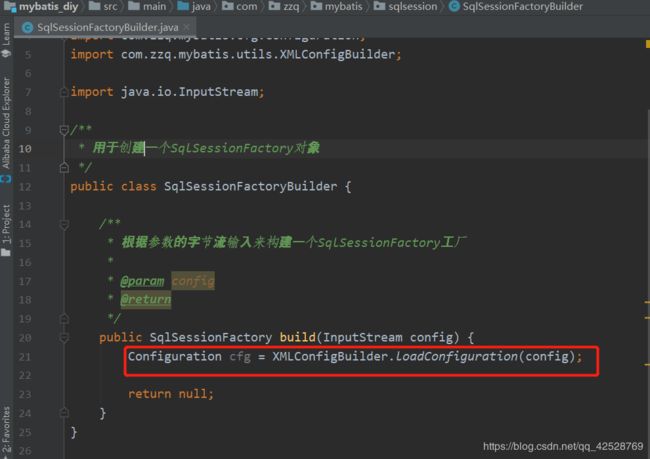MyBatis之自定义MyBatis框架(三)
概述
(一)执行查询所有的分析
(二)创建代理对象的分析
(三)创建所需的类和接口
(四)解析XML的工具类介绍
(五)分析类、接口之间的关系
(六)实现基于XML的查询所有操作
(七)实现基于注解配置的查询所有操作
(一)执行查询所有的分析
mybatis在使用代理dao的方式实现增删改查时做了两件事:
第一,创建代理对象
第二,使用代理对象调用selectList

(二)创建代理对象的分析
(三)创建所需的类和接口
之前入门案例中跟mybatis相关的类和接口:
class Resources
class SqlSessionFactoryBuilder
interface SqlSessionFactory
interface SqlSession
我们依然是基于入门案例的项目结构,只是把pom.xml的mybatis坐标去掉

我们第一步先创建Resources类,如下:

/**
* 使用类加载器读取配置文件的类
*/
public class Resources {
/**
* 根据传入的参数,获取一个字节输入流
*
* @param filePath
* @return
*/
public static InputStream getResourceAsStream(String filePath) {
return Resources.class.getClassLoader().getResourceAsStream(filePath);
}
}
接下来创建SqlSessionFactoryBuilder类,如下:
该类的主要作用是:根据参数的字节流输入来构建一个SqlSessionFactory工厂



到这里为止,所需要的接口和类已经创建完成
(四)解析XML的工具类介绍
我们看回Resources类,毫无疑问需要读取XML文件
(我们先把IUserDao.xml和SqlMapConfig.xml里面跟mybatis有关的约束删掉)

所以我们需要使用XML工具类去解析XML
我们创建一个utils包,导入资料的工具类文件,添加dom4j和jaxen的坐标
package com.zzq.mybatis.utils;
import com.zzq.mybatis.cfg.Configuration;
import com.zzq.mybatis.cfg.Mapper;
import com.zzq.mybatis.io.Resources;
import org.dom4j.Attribute;
import org.dom4j.Document;
import org.dom4j.Element;
import org.dom4j.io.SAXReader;
import java.io.IOException;
import java.io.InputStream;
import java.util.HashMap;
import java.util.List;
import java.util.Map;
/**
* @author 黑马程序员
* @Company http://www.ithiema.com
* 用于解析配置文件
*/
public class XMLConfigBuilder {
/**
* 解析主配置文件,把里面的内容填充到DefaultSqlSession所需要的地方
* 使用的技术:
* dom4j+xpath
*/
public static Configuration loadConfiguration(InputStream config) {
try {
//定义封装连接信息的配置对象(mybatis的配置对象)
Configuration cfg = new Configuration();
//1.获取SAXReader对象
SAXReader reader = new SAXReader();
//2.根据字节输入流获取Document对象
Document document = reader.read(config);
//3.获取根节点
Element root = document.getRootElement();
//4.使用xpath中选择指定节点的方式,获取所有property节点
List<Element> propertyElements = root.selectNodes("//property");
//5.遍历节点
for (Element propertyElement : propertyElements) {
//判断节点是连接数据库的哪部分信息
//取出name属性的值
String name = propertyElement.attributeValue("name");
if ("driver".equals(name)) {
//表示驱动
//获取property标签value属性的值
String driver = propertyElement.attributeValue("value");
cfg.setDriver(driver);
}
if ("url".equals(name)) {
//表示连接字符串
//获取property标签value属性的值
String url = propertyElement.attributeValue("value");
cfg.setUrl(url);
}
if ("username".equals(name)) {
//表示用户名
//获取property标签value属性的值
String username = propertyElement.attributeValue("value");
cfg.setUsername(username);
}
if ("password".equals(name)) {
//表示密码
//获取property标签value属性的值
String password = propertyElement.attributeValue("value");
cfg.setPassword(password);
}
}
//取出mappers中的所有mapper标签,判断他们使用了resource还是class属性
List<Element> mapperElements = root.selectNodes("//mappers/mapper");
//遍历集合
for (Element mapperElement : mapperElements) {
//判断mapperElement使用的是哪个属性
Attribute attribute = mapperElement.attribute("resource");
if (attribute != null) {
System.out.println("使用的是XML");
//表示有resource属性,用的是XML
//取出属性的值
String mapperPath = attribute.getValue();//获取属性的值"com/itheima/dao/IUserDao.xml"
//把映射配置文件的内容获取出来,封装成一个map
Map<String, Mapper> mappers = loadMapperConfiguration(mapperPath);
//给configuration中的mappers赋值
cfg.setMappers(mappers);
} else {
// System.out.println("使用的是注解");
// //表示没有resource属性,用的是注解
// //获取class属性的值
// String daoClassPath = mapperElement.attributeValue("class");
// //根据daoClassPath获取封装的必要信息
// Map mappers = loadMapperAnnotation(daoClassPath);
// //给configuration中的mappers赋值
// cfg.setMappers(mappers);
}
}
//返回Configuration
return cfg;
} catch (Exception e) {
throw new RuntimeException(e);
} finally {
try {
config.close();
} catch (Exception e) {
e.printStackTrace();
}
}
}
/**
* 根据传入的参数,解析XML,并且封装到Map中
*
* @param mapperPath 映射配置文件的位置
* @return map中包含了获取的唯一标识(key是由dao的全限定类名和方法名组成)
* 以及执行所需的必要信息(value是一个Mapper对象,里面存放的是执行的SQL语句和要封装的实体类全限定类名)
*/
private static Map<String, Mapper> loadMapperConfiguration(String mapperPath) throws IOException {
InputStream in = null;
try {
//定义返回值对象
Map<String, Mapper> mappers = new HashMap<String, Mapper>();
//1.根据路径获取字节输入流
in = Resources.getResourceAsStream(mapperPath);
//2.根据字节输入流获取Document对象
SAXReader reader = new SAXReader();
Document document = reader.read(in);
//3.获取根节点
Element root = document.getRootElement();
//4.获取根节点的namespace属性取值
String namespace = root.attributeValue("namespace");//是组成map中key的部分
//5.获取所有的select节点
List<Element> selectElements = root.selectNodes("//select");
//6.遍历select节点集合
for (Element selectElement : selectElements) {
//取出id属性的值 组成map中key的部分
String id = selectElement.attributeValue("id");
//取出resultType属性的值 组成map中value的部分
String resultType = selectElement.attributeValue("resultType");
//取出文本内容 组成map中value的部分
String queryString = selectElement.getText();
//创建Key
String key = namespace + "." + id;
//创建Value
Mapper mapper = new Mapper();
mapper.setQueryString(queryString);
mapper.setResultType(resultType);
//把key和value存入mappers中
mappers.put(key, mapper);
}
return mappers;
} catch (Exception e) {
throw new RuntimeException(e);
} finally {
in.close();
}
}
// /**
// * 根据传入的参数,得到dao中所有被select注解标注的方法。
// * 根据方法名称和类名,以及方法上注解value属性的值,组成Mapper的必要信息
// *
// * @param daoClassPath
// * @return
// */
// private static Map loadMapperAnnotation(String daoClassPath) throws Exception {
// //定义返回值对象
// Map mappers = new HashMap();
//
// //1.得到dao接口的字节码对象
// Class daoClass = Class.forName(daoClassPath);
// //2.得到dao接口中的方法数组
// Method[] methods = daoClass.getMethods();
// //3.遍历Method数组
// for (Method method : methods) {
// //取出每一个方法,判断是否有select注解
// boolean isAnnotated = method.isAnnotationPresent(Select.class);
// if (isAnnotated) {
// //创建Mapper对象
// Mapper mapper = new Mapper();
// //取出注解的value属性值
// Select selectAnno = method.getAnnotation(Select.class);
// String queryString = selectAnno.value();
// mapper.setQueryString(queryString);
// //获取当前方法的返回值,还要求必须带有泛型信息
// Type type = method.getGenericReturnType();//Listpackage com.zzq.mybatis.cfg;
/**
* 用于封装执行的SQL语句和结果类型的全限定l类名
*/
public class Mapper {
private String queryString;//SQL
private String resultType;//实体类的全限定类名
public String getQueryString() {
return queryString;
}
public void setQueryString(String queryString) {
this.queryString = queryString;
}
public String getResultType() {
return resultType;
}
public void setResultType(String resultType) {
this.resultType = resultType;
}
@Override
public String toString() {
return "Mapper{" +
"queryString='" + queryString + '\'' +
", resultType='" + resultType + '\'' +
'}';
}
}
package com.zzq.mybatis.cfg;
import java.util.Map;
/**
* 自定义mybatis的配置类
*/
public class Configuration {
private String driver;
private String url;
private String username;
private String password;
private Map<String, Mapper> mappers;
public String getDriver() {
return driver;
}
public void setDriver(String driver) {
this.driver = driver;
}
public String getUrl() {
return url;
}
public void setUrl(String url) {
this.url = url;
}
public String getUsername() {
return username;
}
public void setUsername(String username) {
this.username = username;
}
public String getPassword() {
return password;
}
public void setPassword(String password) {
this.password = password;
}
public Map<String, Mapper> getMappers() {
return mappers;
}
public void setMappers(Map<String, Mapper> mappers) {
this.mappers.putAll(mappers);//此处需要使用追加的方式,不然的话会覆盖掉
}
}
此时XMLConfigBuilder仍然会有一些报错,先不管它
(五)分析类、接口之间的关系
/**
* SqlSessionFactory接口的实现类
*/
public class DefaultSqlSessionFactory implements SqlSessionFactory {
private Configuration cfg;
/**
* 从SqlSessionFactoryBuilder拿cfg
*
* @param cfg
*/
public DefaultSqlSessionFactory(Configuration cfg) {
this.cfg = cfg;
}
/**
* 用于创建一个新的操作数据库对象
*
* @return
*/
public SqlSession openSession() {
return null;
}
}
并且补全SqlSessionFactoryBuilder的build方法,如下:

然后再新建一个实现类
public class DefaultSqlSession implements SqlSession {
private Configuration cfg;
public DefaultSqlSession(Configuration cfg) {
this.cfg = cfg;
}
/**
* 用于创建代理对象
*
* @param daoInterfaceClass dao的接口字节码
* @param
* @return
*/
public <T> T getMapper(Class<T> daoInterfaceClass) {
return null;
}
/**
* 用于释放资源
*/
public void close() {
}
}
并且补全DefaultSqlSessionFactory的openSession方法,如下:

到这里做一个小总结:
只有工厂有了cfg,就相当于全部类有了cfg(通过有参构造传递)
(六)实现基于XML的查询所有操作
后面项目出了BUG,就不继续写代码了,再复习一遍这张图就好了


